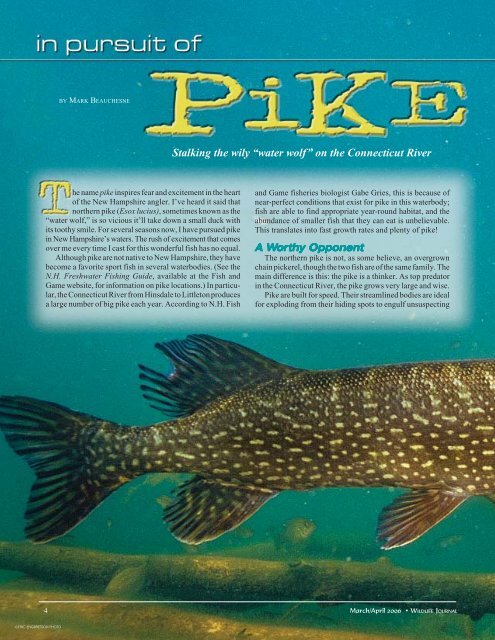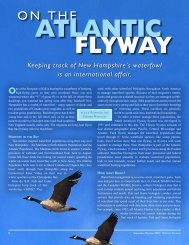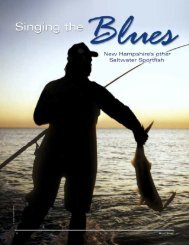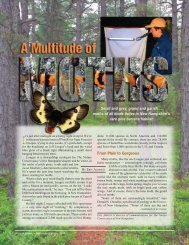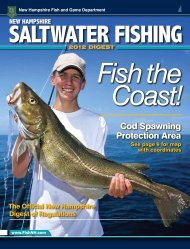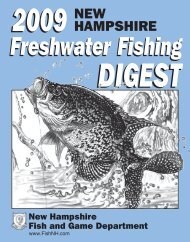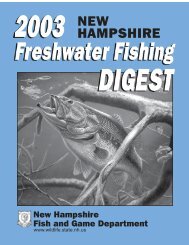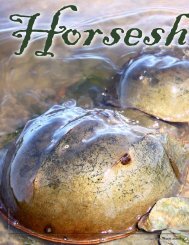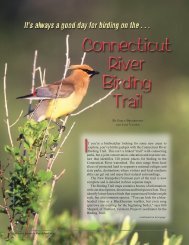In Pursuit of Pike - New Hampshire Fish and Game Department
In Pursuit of Pike - New Hampshire Fish and Game Department
In Pursuit of Pike - New Hampshire Fish and Game Department
Create successful ePaper yourself
Turn your PDF publications into a flip-book with our unique Google optimized e-Paper software.
BY MARK BEAUCHESNEStalking the wily “water wolf” on the Connecticut Riverhe name pike inspires fear <strong>and</strong> excitement in the heart<strong>of</strong> the <strong>New</strong> <strong>Hampshire</strong> angler. I’ve heard it said thatnorthern pike (Esox lucius), sometimes known as the“water wolf,” is so vicious it’ll take down a small duck withits toothy smile. For several seasons now, I have pursued pikein <strong>New</strong> <strong>Hampshire</strong>’s waters. The rush <strong>of</strong> excitement that comesover me every time I cast for this wonderful fish has no equal.Although pike are not native to <strong>New</strong> <strong>Hampshire</strong>, they havebecome a favorite sport fish in several waterbodies. (See theN.H. Freshwater <strong>Fish</strong>ing Guide, available at the <strong>Fish</strong> <strong>and</strong><strong>Game</strong> website, for information on pike locations.) <strong>In</strong> particular,the Connecticut River from Hinsdale to Littleton producesa large number <strong>of</strong> big pike each year. According to N.H. <strong>Fish</strong><strong>and</strong> <strong>Game</strong> fisheries biologist Gabe Gries, this is because <strong>of</strong>near-perfect conditions that exist for pike in this waterbody;fish are able to find appropriate year-round habitat, <strong>and</strong> theabundance <strong>of</strong> smaller fish that they can eat is unbelievable.This translates into fast growth rates <strong>and</strong> plenty <strong>of</strong> pike!A Wororthy OpponentThe northern pike is not, as some believe, an overgrownchain pickerel, though the two fish are <strong>of</strong> the same family. Themain difference is this: the pike is a thinker. As top predatorin the Connecticut River, the pike grows very large <strong>and</strong> wise.<strong>Pike</strong> are built for speed. Their streamlined bodies are idealfor exploding from their hiding spots to engulf unsuspecting4 March/April 2006 • WILDLIFE JOURNAL©ERIC ENGBRETSON PHOTO
prey. Known as “sight predators,” pike have very large eyesthat are focused forward. <strong>Pike</strong> also rely heavily on the “lateralline” — an amazing sensory system that gives them excellentawareness <strong>of</strong> their physical surroundings — to help locateprey. <strong>Pike</strong> have an added advantage to their lateral linesystem: a row <strong>of</strong> tiny pores on the underside <strong>of</strong> the lower jaw.These pores have miniscule hairs inside them that react tovibrations in the water <strong>and</strong> are directly linked with the lateralline system for super sensitivity.<strong>Pike</strong> have a distinctive pattern that will help you distinguishthem from pickerel — light-colored bean shapes over adark background. Also, the pike’s gill plate is only scaled onthe upper half, whereas the chain pickerel’s is fully scaled.With specialized predatory tools including a mouth full <strong>of</strong>knife-edged teeth, the pike is a worthy opponent. Underst<strong>and</strong>ingthese tools is just a part <strong>of</strong> being successful when fishing forpike.Follow the <strong>Fish</strong>Their habitat <strong>and</strong> seasonal location play a vital role incatching pike consistently. <strong>Pike</strong> get an early start on spawning,moving into the backwaters <strong>of</strong> the Connecticut to spawnin late March. They rarely wait for open water <strong>and</strong> will spawnunder the ice. Since these backwater areas are the first to warmup in the spring, many other river fish use these areas forspawning, too. The pike are there, awaiting their arrival.Spring <strong>of</strong>fers the pike a steady diet <strong>of</strong> sunfish, perch, bass,frogs, salam<strong>and</strong>ers — <strong>and</strong> yes, ducklings <strong>and</strong> small mammals.A pike will eat just about anything. But don’t be fooledby the pike’s omnivorous appetite: they can be frustrating tohook.<strong>In</strong> April, the air <strong>and</strong> water temperatures tend to be in the40s. The sun will do its job on the backwaters, warming theseareas <strong>and</strong> bringing the pike onto the feed as the water heats upto 50 degrees or so. Water temperatures are a key factor. Toocold <strong>and</strong> the fish will be sluggish; too warm, the pike moveout.But 50°F is just right, so it’s time for the first trip <strong>of</strong> the yearto the river. My friends <strong>and</strong> I are armed with both spinning <strong>and</strong>fly fishing tackle — imitation baitfish lures <strong>and</strong> flies, a strongspinning rod with ten-pound test line. We’re carrying a sevenweightfly rod with a floating or intermediate line. Both thespinning rod <strong>and</strong> the fly rod get extra protection from thecontinued on next pageWILDLIFE JOURNAL • March/April 2006 5
CHOICE LURES AND FLIES FOR PIKE●Mepps Musky Killer spinner in black <strong>and</strong> yellow is great for fishing theearly season. This spinner really thumps hard on a slow retrieve.●A floating Rapala, fished slowly in the spring, will turn the heads <strong>of</strong> manypike. This lure is also good for the summer months — fish it deeper <strong>and</strong>faster.●A large Daredevil spoon (right)is a classic pike-catcher. Thewobble, flash <strong>and</strong> vibrations <strong>of</strong>this spoon are a terrific tease.●A large willow-leaf style spinner bait in the “clown” color brought me mybiggest pike yet. I like this one for an all-season lure: fish it slow in thespring, burn it in the summer. There isn’t a pike that can resist this bait inthe fall.●S<strong>of</strong>t plastic baitfish lures like the Super Fluke have their place all seasonlong. I adjust my pace when I fish this lure, <strong>and</strong> adjust the weight assummer progresses. The slow-dying action <strong>of</strong> this lure is irresistible topike.●Topwater propeller-type baits are a blast to fish — brace yourself for apike explosion!Chasing pike with a fly rod? There are many great flies to choose from.Here are a few <strong>of</strong> my favorites:●Lefty’s Deceiver in yellow.●Red <strong>and</strong> white Seaducer.●Red <strong>and</strong> white deer-hair popper.●The double bunny in chartreuse & white.●Red <strong>and</strong> white rabbit strip diver (above).pike’s teeth with about a foot <strong>of</strong> steel leader. Thisstuff works great — <strong>and</strong> it’s your best insuranceagainst getting your favorite lure snapped <strong>of</strong>f.We work the shoreline <strong>and</strong> any visible weedbeds, where the pike are hiding <strong>and</strong> waiting forfood to swim or float past. Suddenly, the waterrises up behind my spinner. It’s a pike for sure!The fish is in full view; the eyes <strong>of</strong> the pike arelocked onto my spinner, <strong>and</strong> my heart is high inmy throat. The pike is either going to inhale my<strong>of</strong>fering or follow it to consider the color, shape orspeed. The pike continues to chase my spinner —almost back to the boat. I maneuver the rod infigure eights, trying to enrage the pike. Withoutwarning, the pike turns <strong>and</strong> slowly swims away.But what a rush!Best Bets for Late SeasonLater on in the spring, the backwaters <strong>of</strong> theConnecticut have become too warm for the pike,so they take the stage in the main river. Having astrong liking for weeds, pike will seek refuge inareas where weed growth is visible. They alsohang out among downed trees, rocks or any sort <strong>of</strong>break in the current. You can use the same anglingtactics as you did earlier in the year; but the foodDon’t stick yourthumb in here! Thepike’s arsenal <strong>of</strong>knife-edged, pointedteeth demonstratesthe need for usingwire leaders.©GABE GRIES PHOTO6 March/April 2006 • WILDLIFE JOURNAL
choices are improved in the mainriver, making the pike a bit fussier.(See page 6 for top bait picks.)Come summer, when the river isjust right for swimming, the pikefishing slows down. But you’ll stillhave quality shots at pike, especiallyon cloudy days. <strong>Fish</strong>ing in the earlymornings or until the last bit <strong>of</strong> lightare summertime best bets. Think <strong>of</strong>the river as a set <strong>of</strong> steps: the top stepis the visible bank. Down one step<strong>and</strong> you’re at the weed line. Downanother step you’ll find the submerged weed line.That’s where the pike are in midsummer — thewater is cooler, <strong>and</strong> sunlight is less <strong>of</strong> a factor.Having proper position on the weed line is amust, <strong>and</strong> it’s why most pike fishing is done froma boat rather than from shore. <strong>Pike</strong> will lie on anyside <strong>of</strong> the weeds — it depends on the temperature<strong>and</strong> the amount <strong>and</strong> angle <strong>of</strong> sunlight. Aligningyourself so you can cast parallel to the weeds willallow you to cover most <strong>of</strong> the weed patch. I alsolike to fish the up-river section <strong>of</strong> the weeds first,then pick a few shots at openings in the weeds.Most <strong>of</strong> the pike I catch around a weed patch comefrom the down-river side.On the outside <strong>of</strong> many <strong>of</strong> the long bends <strong>of</strong> theConnecticut there’s a patch <strong>of</strong> submerged weedsclose to the main river channel that makes a greatsummer spot. The river carries sediment <strong>and</strong>deposits it on the “slower” edge <strong>of</strong> the bend.LIMITS & LAWSThe daily limit <strong>of</strong> one pike per daywith a minimum length <strong>of</strong> 28 incheshelps ensure that large pike are notoverharvested <strong>and</strong> that there are plenty<strong>of</strong> mature fish available to spawn eachspring. Nonetheless, says fisheries biologistGabe Gries, pike are a toppredator; though they are able to coexistwith <strong>and</strong> not negatively impact otherfish species in some waterbodies, theymust NEVER be introduced to newwaterbodies without a thorough biologicalreview <strong>of</strong> the waterbody <strong>and</strong> itscurrent fish population.These sediment deposits, which <strong>of</strong>ten have a wavybottom texture, provide ambush points for thepike <strong>and</strong> therefore productive fishing.By mid-September, water temperatures are onthe way back down. For me, this is when the riverreally shines. The weather is good; the surroundingmountains are flush with fall colors. Best <strong>of</strong>all, the pike are hungry <strong>and</strong> very aggressive. Theyknow that winter is on the way <strong>and</strong> it’s time to puton the feed.I’ll admit it: Thoughts <strong>of</strong> pike fishing consumemost <strong>of</strong> my free time. I am ready for my next shotat a big pike, <strong>and</strong> maybe now you are too. Grabyour rod <strong>and</strong> a few simple lures, tie on a foot <strong>of</strong>steel leader, <strong>and</strong> go feel the rush <strong>of</strong> pike fishing!Mark Beauchesne is coordinator <strong>of</strong> N.H. <strong>Fish</strong> <strong>and</strong><strong>Game</strong>’s Let’s Go <strong>Fish</strong>ing Program. <strong>Fish</strong>eriesbiologist Gabe Gries contributed to this article.MONSTER PIKE ON ICEAt home waiting fordinner: Rocks, weeds<strong>and</strong> woody debrisare prime pikelocations.The state record for northern pike is 45 inches — <strong>and</strong> it was taken through the ice!This monster pike, which weighed just under 25 pounds, was caught by JacquesRenaud <strong>of</strong> Vermont in late March <strong>of</strong>2002.As long as the ice is still safe inlate winter/early spring, ice angerstend to target the pike in the backwaters.(Early ice is highly productive,too.) Big bait is the key to having ashot at getting a pike under the ice —a large sucker, in the 12-inch range,makes for a tempting meal. Tip-upsare the ice fishing tool <strong>of</strong> choice. Besure to add a wire leader.ERIC ENGBRETSON PHOTOCOURTESY PHOTOWILDLIFE JOURNAL • March/April 2006 7


